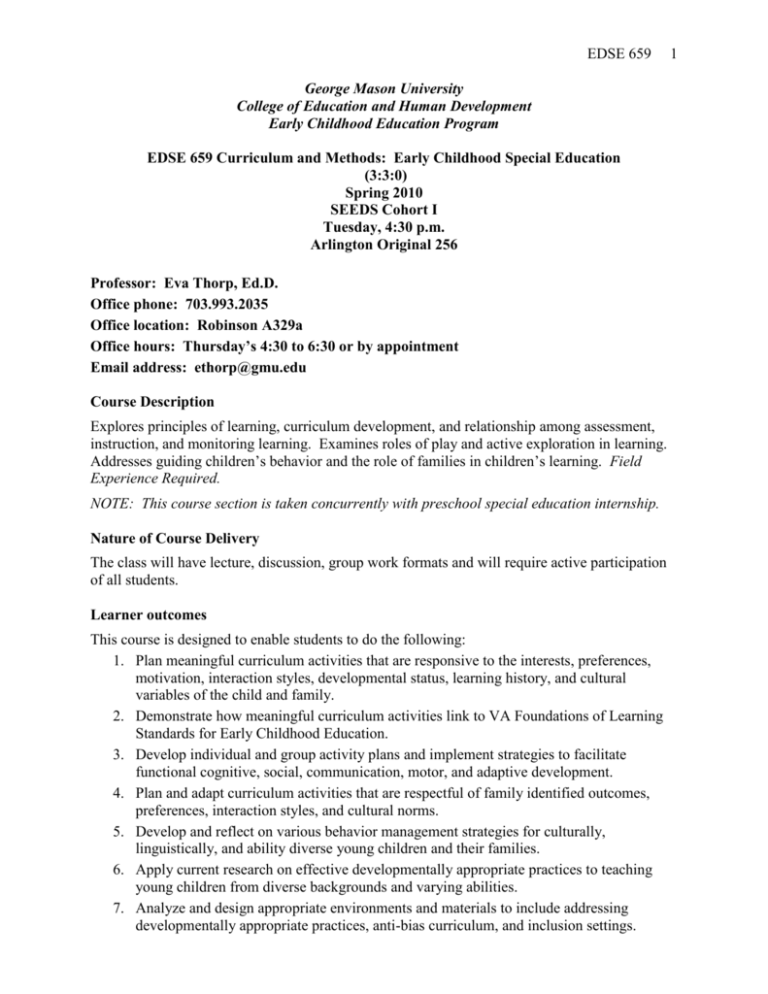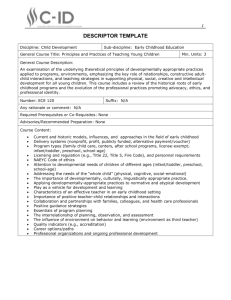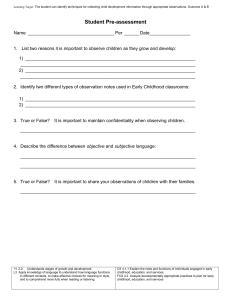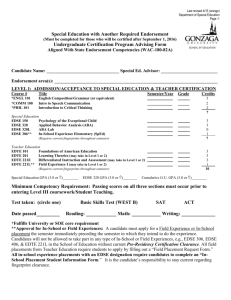Spring 2010 - College of Education and Human Development
advertisement

EDSE 659 George Mason University College of Education and Human Development Early Childhood Education Program EDSE 659 Curriculum and Methods: Early Childhood Special Education (3:3:0) Spring 2010 SEEDS Cohort I Tuesday, 4:30 p.m. Arlington Original 256 Professor: Eva Thorp, Ed.D. Office phone: 703.993.2035 Office location: Robinson A329a Office hours: Thursday’s 4:30 to 6:30 or by appointment Email address: ethorp@gmu.edu Course Description Explores principles of learning, curriculum development, and relationship among assessment, instruction, and monitoring learning. Examines roles of play and active exploration in learning. Addresses guiding children’s behavior and the role of families in children’s learning. Field Experience Required. NOTE: This course section is taken concurrently with preschool special education internship. Nature of Course Delivery The class will have lecture, discussion, group work formats and will require active participation of all students. Learner outcomes This course is designed to enable students to do the following: 1. Plan meaningful curriculum activities that are responsive to the interests, preferences, motivation, interaction styles, developmental status, learning history, and cultural variables of the child and family. 2. Demonstrate how meaningful curriculum activities link to VA Foundations of Learning Standards for Early Childhood Education. 3. Develop individual and group activity plans and implement strategies to facilitate functional cognitive, social, communication, motor, and adaptive development. 4. Plan and adapt curriculum activities that are respectful of family identified outcomes, preferences, interaction styles, and cultural norms. 5. Develop and reflect on various behavior management strategies for culturally, linguistically, and ability diverse young children and their families. 6. Apply current research on effective developmentally appropriate practices to teaching young children from diverse backgrounds and varying abilities. 7. Analyze and design appropriate environments and materials to include addressing developmentally appropriate practices, anti-bias curriculum, and inclusion settings. 1 EDSE 659 2 8. Utilize problem-solving strategies to address dilemmas encountered in diverse educational and community settings. 9. Analyze and describe the varied theoretical frameworks guiding early childhood curriculum approaches and practices. 10. Describe how ongoing data collection and management of classroom plans can be used to monitor child progress in the context of daily activities. 11. Analyze one’s own teaching practices and set appropriate goals for teaching change. 12. Delineate indicators of potential child abuse and recommended steps for appropriate intervention process. Professional standards This course complies with the standards for teacher licensure established by the Council for Exceptional Children (CEC) and the National Association for the Education of Young Children (NAEYC). The course content has been designed to address the following standards and competencies. Council for Exceptional Children (CEC) Standard 7 Instructional Planning National Association for the Education of Young Children (NAEYC) Standard 4 Teaching and Learning (Planning) Virginia Professional Endorsement Competencies Curriculum and instructional procedures Virginia Early Childhood Special Education Endorsement Competencies Understanding of the methods for providing instructional programs for early intervention Understanding of behavior management and the application of principles of learning and child development to individual and group management using a variety of techniques that is appropriate to the age of that child Virginia Early Childhood Education Endorsement Competencies Methods Understanding of behavior management and the application of principles of learning and child development to individual and group management using a variety of techniques that is appropriate to the age of that child Required Texts Cowhey, M. (2006). Black ants and Buddhists: Thinking critically and teaching differently in the primary grades. Portland, ME: Stenhouse. Gartrell, D. (2004). The power of guidance: Teaching social-emotional skills in early childhood classrooms. Washington, D.C.: NAEYC. Hyson, M. (2008). Enthusiastic and engaged learners: Approaches to learning in the early childhood classroom. New York: Teacher’s College. Hull, K., Goldhaber, J., & Capone, A. (2002). Opening doors: An introduction to inclusive early childhood education. Boston: Houghton Mifflin. EDSE 659 3 Recommended and Resource Texts Bodrova, E. & Leong, D.J. (1996). Tools of the mind: The Vygotskian approach to early childhood education. Columbus, OH: Merrill. ISBN: 0-02-369874-8 Copple, C. & Bredekamp, S., Eds. (2009). Developmentally appropriate practice in early childhood programs serving children from birth through age 8. Washington, DC: National Association for the Education of Young Children. ISBN: 978-1-928896-64-7 Derman-Sparks, L. & Olsen Edwards, J. (2010). Anti-bias education for young children and ourselves. Washington, DC: National Association for the Education of Young Children. ISBN: 978-1-928896-67-8 Hemmeter, M.L., Smith, B., Sandall, S., and Askew, L., (2005). DEC Recommended Practices Workbook. Missoula, MT: Division for Early Childhood Roopnarine, J., and Johnson, J.E. (2008, 5th Edition) Approaches to early childhood education. Prentice Hall. ISBN: 0135126282 Sandall, S., Hammeter, M.L., Smith, B., and McLean, M. (2005). DEC Recommended Practices: A Comprehensive Guide. Missoula, MT: Division for Early Childhood Sandall, S., Giacomini,A., Smith, B., and Hemmeter, M.L., (2006). DEC Recommended Practices Toolkit: Interactive Tools to Improve Practices for Young Children with Special Needs and Their Families (CD) Missoula, MT: Division for Early Childhood Course Requirements General Requirements 1. The completion of all readings assigned for the course is assumed. Because the class will be structured around discussion and small group activities, it is imperative that students keep up with the readings and participate in class. 2. Class attendance is important. If, due to an emergency, students will not be in class, they must call the instructor and leave a message or contact the instructor via email. 3. The university requires that all pagers and cell phones be turned off before class begins. Laptops and other electronic devises are to be used for educational and learning purposes only and should not be used during class time to check email, surf the web, or communicate with people outside of the class unless part of the class activity. 4. It is expected that assignments will be turned in on time (the beginning of the class in which they are due). However, it is recognized that graduate students occasionally have serious problems that prevent work completion. If such a dilemma arises, students should speak to the instructor in a timely fashion. On the other hand, a pattern of late assignments will affect the course grade. EDSE 659 4 Attendance Attendance in class is important to students’ learning; therefore, students are expected to make every effort to attend class sessions. Absences, tardiness, and leaving early may negatively affect course grades. The following policy is from the university course catalog: Students are expected to attend the class periods of the courses for which they register. In-class participation is important not only to the individual student, but also to the class as a whole. Because class participation may be a factor in grading, instructors may use absence, tardiness, or early departure as de facto evidence of nonparticipation. Students who miss an exam with an acceptable excuse may be penalized according to the individual instructor’s grading policy, as stated in the course syllabus. Written Assignments All written assignments prepared outside of class will be evaluated for content and presentation as graduate-level writing. The American Psychological Association, Sixth Edition (APA) style will be followed for all written work. All written work unless otherwise noted must be completed on a word processor and should be proofread carefully. (Use spell check!) If students are not confident of their own ability to catch errors, they should have another person proofread their work. When in doubt, they should check the APA manual. Portions of the APA manual appear at the Style Manuals link on the Mason library web guide at http://library.gmu.edu/resources/edu/. Students will 1. Present ideas in a clear, concise, and organized manner. (Avoid wordiness and redundancy.) 2. Develop points coherently, definitively, and thoroughly. 3. Refer to appropriate authorities, studies, and examples to document where appropriate. (Avoid meaningless generalizations, unwarranted assumptions, and unsupported opinions.) 4. Use correct capitalization, punctuation, spelling, and grammar. Grading Criteria A = 95 – 100 A- = 90 – 94 B+ = 87 – 89 B = 83 – 86 B- = 80 – 82 C = 70 – 79 F = < 70 A+ is possible if work is of exceptional high quality and includes work above and beyond that required for the course. Grading Policy All CEHD undergraduate and graduate students are held to the university grading policies as described in the Academic Policies section of the catalog: http://catalog.gmu.edu/content.php?catoid=5&navoid=104. Those students enrolled in a CEHD licensure program, however, must earn a B- or better in all licensure coursework. A degreeseeking graduate student will be dismissed after accumulating grades of F in two courses or 9 credits of unsatisfactory grades (C or F) in graduate courses. A 3.0 grade point average is required for completion of the graduate degree. EDSE 659 5 Submission of Performance-Based Assessment This course has a Program Performance-Based Assessment (PBA) that MUST be uploaded and submitted to Task Stream for evaluation when the assignment is due. Only PBAs posted to TaskStream will be graded. This means that NO final grades will be posted until all materials are on Task Stream. CEHD Syllabus Statements of Expectations All students must abide by the following: Students are expected to exhibit professional behavior and dispositions. See http://gse.gmu.edu/facultystaffres/profdisp.htm for a listing of these dispositions. Students must follow the guidelines of the University Honor Code. See http://www.gmu.edu/catalog/apolicies/#Anchor12 for the full honor code. Students must agree to abide by the university policy for Responsible Use of Computing. See http://www.gmu.edu/facstaff/policy/newpolicy/1301gen.html. Click on responsible Use of Computing Policy at the bottom of the screen. Students with disabilities who seek accommodations in a course must be registered with the GMU Disability Resource Center (DRC) and inform the instructor, in writing, at the beginning of the semester. See http://www.gmu.edu/student/drc/ or call 703-993-2474 to access the DRC. Assignments Attendance and Participation (15 points) Because active participation and engagement are imperative for optimal learning, preparation for and participation in in-class activities will be evaluated based on the following criteria: Students attend class, arrive on time, and stay for the entire class period. Students complete readings and prepare for class activities prior to class as is evidenced by their ability to discuss and write about the concepts presented and examined in the texts as well as participate fully in related activities. Students are actively involved in in-class learning experiences as is evidenced by (1) participating in all activities, (2) engaging in small and large group discussions, (3) completing written work related to the activities, and (4) supporting the participation and learning of classmates. Students show evidence of critical reflective thinking through in-class discussions, activities, and written reflections. Dilemmas of Practice (15 points) Over the course of your internship, you will be asked to collect dilemmas of practice and bring them to class for discussion and linking to course themes and readings. The dilemma form is attached to this syllabus. Dilemmas should describe a single situation which you observed or in EDSE 659 6 which you were a participant. Dilemmas should not be a listing of things that have gone wrong over time or describe a pattern of challenges. Dilemmas help us to focus on a single event and, in making sense of that event, generalize to larger issues of practice. Dilemmas will be due on March 16, March 23, March 30, April 13, and April 20. Each dilemma will be worth three points. Dilemmas must be turned in on the night that they are due and will not be accepted at a later date, as they are used to inform discussion that night. Curriculum Content Area: Exploration and Resources (20 points) Students will select and research curriculum content areas and resources to share with classmates. They will prepare an interactive/play/center-based presentation to help communicate the importance of this content area, the key outcomes for children from culturally, linguistically, and ability diverse backgrounds and their families connected to this area, and examples of activities that would support learning in this area. It is important to consider the students’ ability levels and developmental and cultural appropriateness for preschool-aged children, especially children with special needs. The handout for this project should include the following: a brief statement of the significance of this area and the associated learning outcomes for children from culturally, linguistically, and ability diverse backgrounds; an annotated list of the key resources that contribute to understanding this area; and an annotated list of activity resources that could be used when implementing developmentally and culturally appropriate curriculum or provided to families to support this area of learning; links to validated evidence-based practices with young children with disabilities The topics will include the following: 1) science, 2) music and dance, 3) story telling/language and literacy, 4) social studies, 5) math, and 6) physical/large motor activity/movement. Environmental Analysis and Optimal Design Plan (20 points) This assignment will be completed as part of the field experience requirement. This assignment is completed in two segments. Students will do the following: Analyze and critique an Early Childhood Special Education or Early Childhood Education classroom from the standpoint of developmentally appropriate, multicultural, and inclusive practice setting. Develop, reflect, and analyze an “Optimal” Early Childhood Special Education or Early Childhood Education classroom. Reflect on and analyze the affective, physical, and temporal environment for both settings. Integrated Curriculum Unit (30 points) This is the NCATE 3 Instructional Planning Performance-Based Assessment that shows evidence of meeting CEC Standard 7 Instructional Planning and NCATE Standard 4 Teaching and Learning (Planning). Students will plan an integrated curriculum unit that could be implemented in their field experience or internship classroom. They will design a two-week curriculum unit appropriate for culturally, linguistically, and ability diverse children. The field experience time should be spent getting to know the interests of the children and families. From these interactions, students will plan a child-centered, culturally responsive, inclusive unit. This will serve as a base for EDSE 659 7 curriculum design. NOTE: The plan is to be implemented over a two week period during the full time teaching experience of your internship. Please work with your cooperating teacher to identify those dates (which should occur during April). Developmentally appropriate practice, including all developmental domains Reflections of the cultural, linguistic, and ability diversity in the classroom Reflection of children’s interests and preferences, integrating observations of culturally, linguistically, and ability diverse young children Strategies for including families and community members Students will include the following elements: a. Instructional web b. A minimum of 3-4 detailed/individualized lesson plans c. Description of individual learning centers and the materials to be incorporated in each in order to support the topic d. Evidence of assessment of children’s learning during the unit (i.e., anecdotal notes, running records) e. Different types of activities/learning (child-constructed, teacher-directed, exploration and discovery, small group, large group etc.) f. All curriculum areas (to be discussed in class) g. Plans to address behaviors in the class h. How a sense of community will be created in order to address various behavior management issues i. How standards will be addressed j. Daily lesson plans for the centers created (formats will be discussed in class and may be adapted) k. Children’s literature to support the topic, with annotations and plans for use l. Discussion of how families/community members were or would be involved m. Adaptations or accommodations, as appropriate, for selected individual learners n. Plan for working collaboratively and effectively with your teaching assistant/partner to plan and implement this unit EDSE 659 8 Course Schedule Date Jan 19 Topics Jan 26 Introduction to Curriculum, overview of syllabus Educators without Borders Seminar: Prejudice and Coalition Building – Implications for ECSE Curriculum Investigate various curriculum designs Feb 2 Becoming a Reflective Practitioner Feb 9 Anti-bias education approach/cultural identities/coalition building/advocacy/social justice Learning Centers and the Power of Play Jan 22 Feb 16 Feb 23 Mar 2 Mar 9 Mar 16 Mar 23 Mar 30 Apr 6 Apr 13 Readings & Assignments Due Begin Black Ants Continue Black Ants Continue Black Ants Read Chapter 6, Hyson Finish Black Ants; Read Chapter 3, Hull et al. Read Chapter 1, Hull et al. First Curriculum Presentation Read Chapter 6, Hull et al. Read Chapters 1-4, Hyson Inclusive Practices and Individualization Second Curriculum Presentation Read Chapter 8, Hull et al. The Centrality of Culture in the Early Childhood Third Curriculum Presentation Special Education Classroom; Classroom Read Chapter 7, Hull et al.; Profile; Planning for Cultural Diversity; Read Chapter 7, Hyson Supportive Environments Spring Break: No Class Curriculum Planning, Integrated Curriculum, Dilemma #1 Due Developmentally Appropriate Fourth Curriculum Presentation Read Chapter 5, Hull et al. Planning formats Dilemma #2 Due Reflecting Child-Interest and Standards; The Fifth Curriculum Presentation role of observation, data collection and Read Chapters 2 & 4, Hull et al. assessment Sharing of your children and the context, how Dilemma #3 Due does your topic reflect the students, child Sixth Curriculum Presentation objectives and standards Bring initial integrated plan topic ideas and planning web to class. Classroom Environment Environmental Analysis and Optimal Plan Due Plan/Design/Refine Review Chapter 7, Hull et al. The Guidance Approach Read Gartrell, Chapters 1-3 Behavior Management, Guidance, and Finish Gartrell, Chapters 5 – 10 Challenging Behaviors: Toward an Read Hyson, Chapter 5 EDSE 659 Encouraging Classroom Apr 20 Apr 27 May 4 May 11 Developmentally appropriate literacy development Role of Families and Communities in Informing Curriculum Reading Day Final Presentations of Integrated Curriculum Unit – Upload PBA’s Dilemma #4 Due (focus on behavior management issue) Dilemma #5 Due Read Gartrell, Chapter 4; Hyson, Chapter 9 Review Hull, chapter 9. Final Curriculum Unit Paper Due Note: To determine whether the campus is closed due to inclement weather, call 703-993-1000 or go to www.gmu.edu. 9 EDSE 659 Dilemma of Practice #1, 2, 3, 4, 5 (Circle one) Name:________________ Date:______________________ Setting (Please use no names or use pseudonyms to maintain confidentiality): People Involved (descriptors or first name only): Description of Situation (include background information we may need to understand): Identify what felt perplexing about the situation (avoid all judgment, just help us understand what you were wondering): 10









